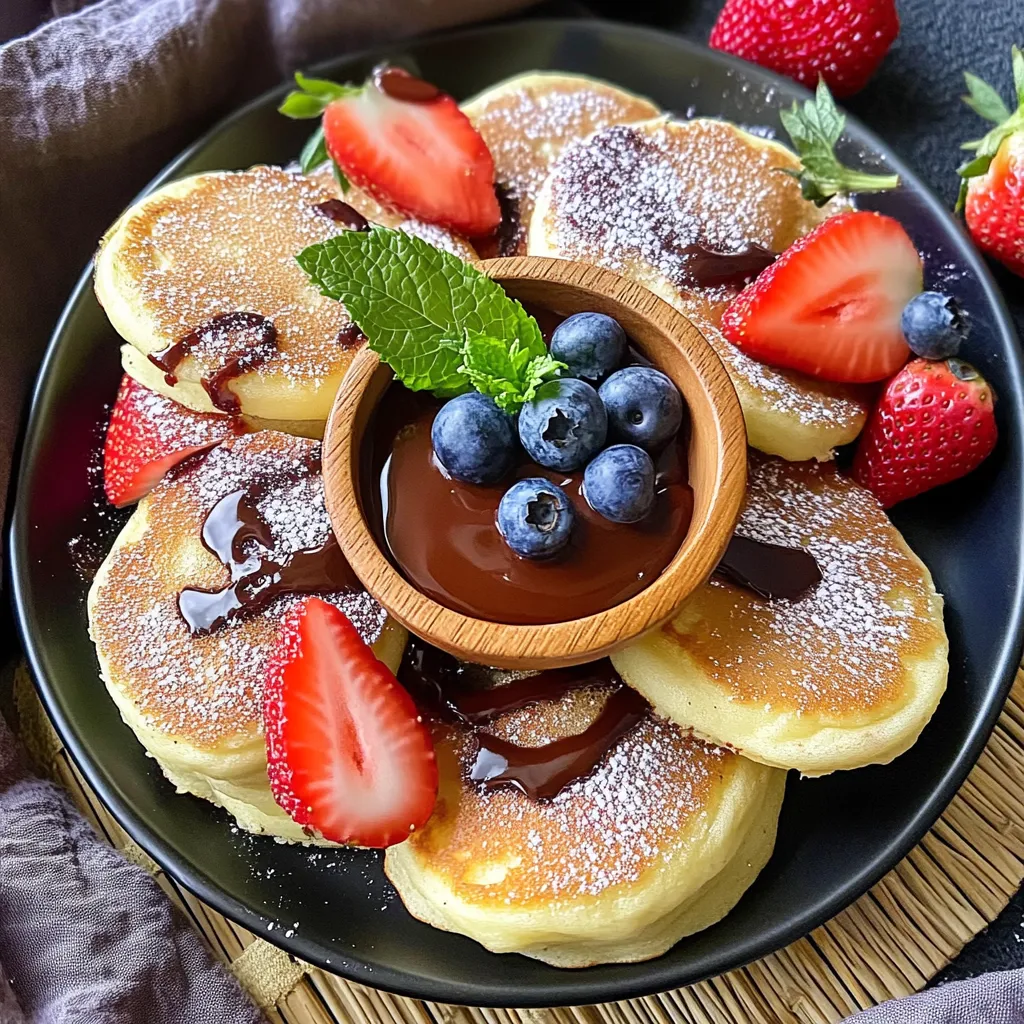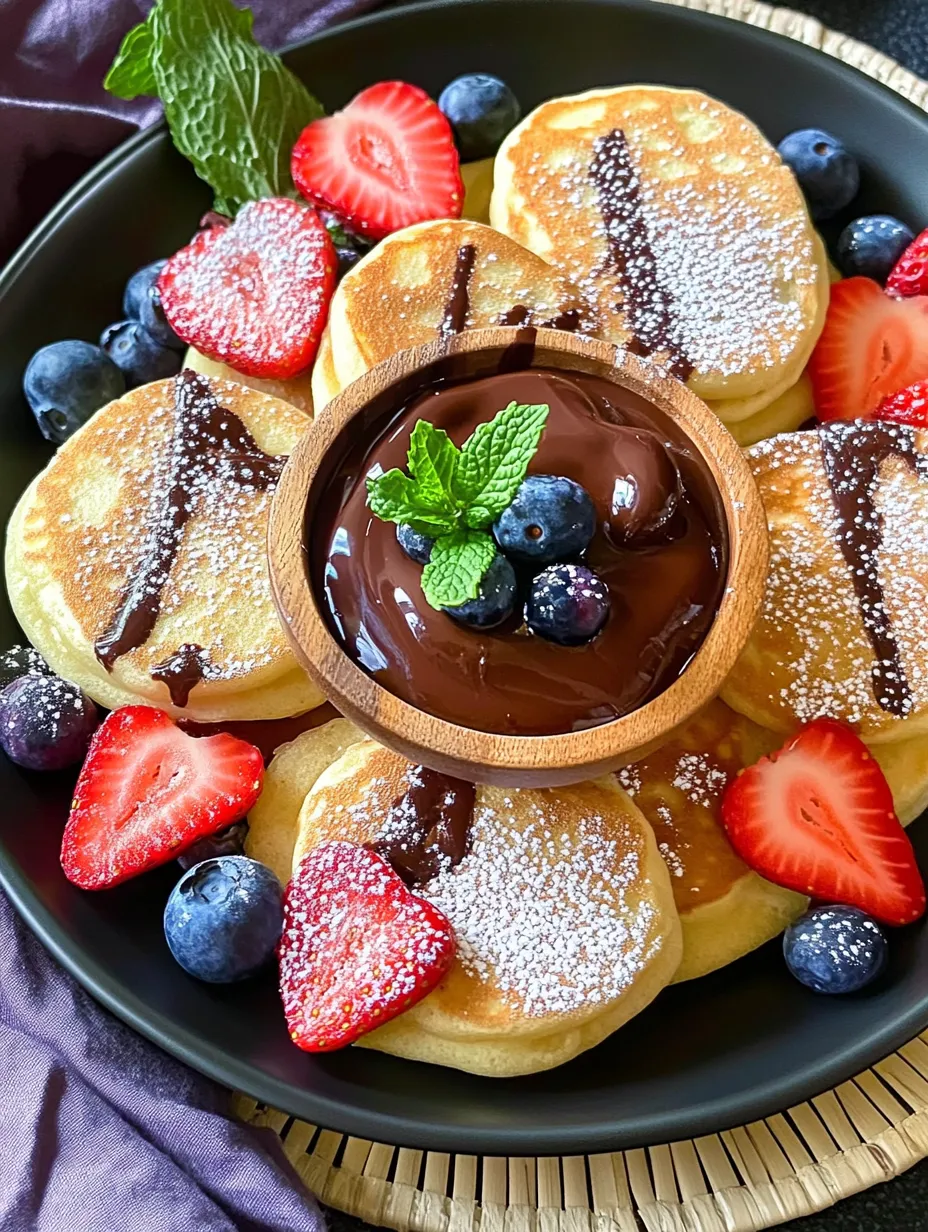 Pin it
Pin it
Heavenly soft pancakes with airy texture pamper the palate and literally melt in your mouth. These special American pancakes impress with their incredible fluffiness and delicate flavor, which forms a perfect base for various toppings. The secret lies in the use of buttermilk and the special preparation technique, which even beginners can master and creates a first-class breakfast experience in just a few minutes.
When I tried this recipe for the first time, I was literally amazed at the result. My pancakes were always quite flat and compact before, but this version practically towered on the plate. My children were so excited about the cloud-like pancakes that they now ask for them every Sunday morning. What particularly pleases me: Despite the impressive appearance and excellent taste, the preparation is surprisingly simple.
The Secret to Fluffiness
- Beaten egg whites: Ensure the incomparable airiness and light texture
- Buttermilk: Reacts with baking powder and baking soda, creating additional air bubbles
- Resting time: The short resting time allows the batter to slightly activate and enhances the fluffy effect
- Heat: The right heat when cooking preserves the airiness and ensures even browning
- Ingredients: Fresh ingredients at room temperature improve batter binding and rising
- Folding the batter: Careful folding of the batter preserves the incorporated air
- Serving: Immediate serving guarantees the perfect consistency
The combination of these factors makes the decisive difference. I was particularly impressed by how the beaten egg whites transform the batter. As they are incorporated, you can literally see how the batter gains volume and lightness. I have since transferred this technique to other baking recipes, with amazing results.
 Pin it
Pin it
The Secret of Ingredients
- Buttermilk: Gives the pancakes a fine touch of acidity and reacts with the baking soda for optimal fluffiness
- All-purpose flour: Is best suited for the delicate structure of these special pancakes
- Fresh eggs: Should be at room temperature for better whipping of the egg whites
- Fine sugar: Dissolves better in egg whites and provides stability when whipping
- Vanilla extract: Underscores the sweetness and provides aromatic depth
- Baking soda: Together with baking powder creates the perfect leavening effect
- Baking powder: Supports even rising and the light structure
- Coconut oil: Gives a subtle flavor and ensures a beautiful browning
The quality of the buttermilk plays a decisive role. I prefer buttermilk with a high fat content, as it gives the pancakes a special creaminess. If no buttermilk is on hand, you can mix regular milk with a teaspoon of lemon juice or vinegar and let it stand for five minutes – a simple substitute that works surprisingly well.
Preparation Process
- Separate eggs:
- Carefully separate the eggs, ensuring no yolk gets into the whites. This is best done with an egg separator or by gently sliding the yolk back and forth between the eggshell halves. The egg whites should be collected in a fat-free bowl, as even the smallest fat residues can prevent optimal whipping.
- Beat egg whites:
- First beat the egg whites slowly, then gradually add the sugar and continue beating until stiff peaks form. The right consistency is recognized when the bowl can be held upside down without the egg whites falling out. The beating time is about 3-4 minutes with an electric hand mixer.
- Mix liquid ingredients:
- In a separate bowl, whisk the egg yolks with vanilla extract and buttermilk until a homogeneous mixture forms. The liquid should have a uniform, slightly thick consistency. This forms the base for the batter, into which the dry ingredients will later be incorporated.
- Incorporate dry ingredients:
- Sift flour, baking powder, and baking soda into a bowl and mix lightly. Add the dry ingredients to the liquid mixture and gently fold in with a rubber spatula until just combined. Do not stir too vigorously, as this can activate gluten and make the pancakes tough.
- Fold in egg whites:
- Carefully fold the stiff egg whites into the batter in three portions. Work with a folding motion from bottom to top to preserve as much air as possible in the batter. The finished batter should be airy and light, with visible white streaks from the egg whites.
- Let batter rest:
- Let the finished batter rest for about 10 minutes. During this time, the ingredients can combine, and the reaction between acid and baking soda begins. The resting time is short but crucial for the texture of the finished pancakes.
- Cook pancakes:
- Heat a coated pan with some coconut oil over medium heat. Depending on the pan size, add about 2-3 tablespoons of batter per pancake to the pan. When small bubbles form on the surface and the edges become slightly firm, carefully flip the pancake and cook for another 1-2 minutes.
Worth Knowing
- Airy pancakes: Contain more volume at the same weight and therefore seem more filling
- Buttermilk and baking soda: Were traditionally used before baking powder was widespread
- Beaten egg white: Consists of 90% air, which explains the extraordinary fluffiness
My family has developed a special tradition around these pancakes. Every Sunday, a different family member gets to determine the toppings. My son loves them with chocolate sauce and bananas, my daughter prefers maple syrup and berries, while my husband likes them best with peanut butter and a touch of salt. What personally excites me about this recipe is the versatility. The neutral, slightly sweet pancakes form a perfect base for creative combinations, and I have great fun trying out new flavors.
The Art of Serving
These fluffy masterpieces should be served immediately after preparation, when they are still warm and particularly airy. Classically, maple syrup and some melted butter are suitable, slowly penetrating the airy layers and creating a harmonious taste experience. For a fruity variation, fresh berries and a light layer of powdered sugar are ideal, their acidity and sweetness harmonizing perfectly with the mild pancake batter. For those who like it particularly decadent, drizzle melted chocolate and chopped nuts over the top, which is especially popular with children.
Flavor Variations
This basic recipe can be wonderfully adapted to personal preferences. For citrus lovers, I recommend adding freshly grated lemon zest and a splash of lemon juice to the batter, which provides a refreshing note, especially in summer. For an autumnal variation, stir a teaspoon of cinnamon and a pinch of nutmeg into the batter and serve the pancakes with sautéed apples and caramel sauce. Chocolate fans will love adding a tablespoon of cocoa and small chocolate pieces to the batter, which melt slightly during baking and create flavor explosions.
 Pin it
Pin it
The Art of Storage
Although these pancakes taste best fresh, they can be stored surprisingly well. Keep leftover pancakes in an airtight container in the refrigerator for up to two days. For reheating, a toaster or the oven at low temperature works best, which partially restores the fluffiness. The microwave is less suitable as it tends to make the pancakes tough. Alternatively, the uncooked batter can be stored in the refrigerator overnight, but note that it will lose some volume. Before cooking, simply stir gently and prepare as usual.
The discovery of this recipe has permanently changed our weekends. What used to be a rather functional breakfast has now become a real family ritual. We take time, enjoy these fluffy delicacies together, and even plan our Sunday activities around this special breakfast. The joy in my family's faces when the aroma of these special pancakes spreads through the kitchen is priceless. Try this recipe yourself and experience how simple ingredients with the right technique can become an extraordinary taste experience!
Frequently Asked Questions
- → Why should I separate the eggs and beat the whites separately?
- Separately beating the egg whites and then carefully folding them in is the key to exceptionally fluffy pancakes. The beaten whites create air pockets in the batter that make for a light, airy texture when cooking.
- → Can I use regular milk instead of buttermilk?
- Yes, you can use regular milk, but buttermilk gives the pancakes a special flavor and makes them even fluffier due to its acidity. As an alternative, you can mix regular milk with some lemon juice or vinegar (about 1 tablespoon per cup of milk) and let it sit for 5 minutes.
- → Why use both baking powder and baking soda?
- The combination of baking powder and baking soda provides optimal leavening. The baking soda reacts with the acid in the buttermilk while the baking powder gives additional lift. Together they create the perfect fluffiness in the pancakes.
- → Can I prepare the batter in advance and cook later?
- It's best to prepare the batter fresh and use it within 30-60 minutes. If you let it sit too long, the egg whites will lose their fluffiness and the leavening agents (baking powder and baking soda) will no longer work optimally.
- → How do I know when to flip the pancakes?
- The perfect time to flip is when small bubbles form on the surface of the batter and the edges become slightly firm. This usually takes about 2-3 minutes on medium heat. After flipping, they only need about 1-2 minutes more.
- → What can I substitute for coconut oil?
- Instead of coconut oil, you can use butter, neutral vegetable oil like sunflower oil, or even ghee (clarified butter). Coconut oil gives the pancakes a slightly sweet note, while butter provides a classic flavor.
